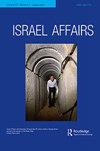Acceptance and perception of multimodal expression of Israeli-Jewish culture in China: ‘The Realist’ comic strip as a case study
IF 0.6
4区 社会学
Q3 AREA STUDIES
引用次数: 0
Abstract
ABSTRACTThis article analyzes the acceptance and perception of Israeli-Jewish culture in China through Chinese translation of ‘The Realist’. It points that most topics Chinese readers could interpret are those shared as general common sense or used in common terminology in all semiotic modes. However, the Israeli-Jewish tradition, literacy and specific practices remained unrecognised for the most part. It argues that the translator’s mediation of comic texts is grounded in processes of multimodal analysis that facilitates comprehension of whether and how a message is understood in a certain context. The translator has the task of making up the target readers’ contextual deficiency.KEYWORDS: IsraelChinacomicsintercultural comprehensionIsraeli-Jewish culturemultimodaltranslation Disclosure statementNo potential conflict of interest was reported by the author(s).Notes1. Van Leeuwen, Introducing Social Semiotics, 160.2. Kress and Van Leeuwen, Multimodal Discourse.3. Pérez-González, “Multimodality,” 126. (black in original).4. Reiss, Possibilities and Limitations.5. Reiss, Foundation.6. Kaindl, “Multimodality in the Translation,” 183.7. Munday, “Translation Studies,” 422.8. Bachmann-Medick. Cultural Turns.9. Kress and Van Leeuwen, Multimodal Discourse, 2.10. Gambier and Gottlieb, (Multi)Media Translation, xix.11. Gurevitch and Gao, “The reception.”12. Pérez-González, “Multimodality,” 121.13. Jauss and Benzinger, “Literary History.”14. Bassnett and Lefevere, Translation, History and Culture.15. Kaindl, “A Theoretical Framework.”16. Adler and Kohn, “Silence in a 9-Panel Grid,” 6.17. Öztürk and Tarakçıoğlu, “Comics and Translation,” 129.18. Jakobson, “On Linguistic Aspects of Translation,” 233.19. Toury, “Translation,” 1114.20. Ibid., 1113.21. Gottlied, Subtitles, Translation and Idioms, 111.22. Remael, “Some Thoughts,” 13–14.23. Lee, “Performing Multimodality,” 241.24. Oittinen, “Where the Wild Things Are”; and Oittinen, “From Thumbelina to Winnie-the-Pooh.”25. Alvstad, “Illustrations and Ambiguity.”26. Pereira, “Book Illustrations.”27. Baumgarten, “Yeah, That’s It!”28. Torresi, “Advertising.”29. Kaindl, “Thump, Whizz, Poom”; and Kaindl, “Multimodality in the Translation.”30. Zanettin, Comics in Translation, 1, 152–171.31. Pastra, “COSMOROE.”32. Borodo, “Multimodality, Translation, and Comics”.33. Gentzler, Translation and Rewriting.34. Groensteen, Comics and Narration, 21.35. Ibid., 23 (emphasis in original).36. Varga, Discourse, Narrative, Image, 98.37. Groensteen, Comics and Narration, 23.38. Appadurai, Modernity at Large.39. See note 17 above.40. Kaindl, “Multimodality and Translation,” 265.41. Ibid.42. https://www.youtube.com/watch?v=bfBA05aVjeo with English subtitle in the original video.43. Tablet, June 18, 2012.44. Haaretz, Aug 22, 2016.45. Van Leeuwen. Introducing Social Semiotics, 29.46. Haaretz, Aug 22, 2016.47. See note 40 above.48. Ibid.49. Donohue, Understanding Scientific Literatures.50. Wan and Biti, “Cosmopolitanism and Trauma Theory,” 2–3.51. Ibid., 3.52. See note 6 above.53. Borodo, “Multimodality, Translation, and Comics,” 23.54. Öztürk and Tarakçıoğlu, “Comics and Translation,” 136.Additional informationFundingThis work was supported by Basic Research Program of Jiangsu Education Department (Grant No. 2019SJA1922).Notes on contributorsXiu GaoXiu Gao is a lecturer of translation studies at Jiangsu University of Science and Technology.Danielle GurevitchDanielle Gurevitch is Director of multidisciplinary studies in the Faculty of Humanities, Bar-Ilan University and Chief Director of The Sir Naim Dangoor Centre https://dangoorcentre.com/.中国对以色列-犹太文化多模态表达的接受与认知——以《现实主义》连环画为例
摘要本文通过《现实主义》的汉译分析了中国对以色列-犹太文化的接受和认知。文章指出,中国读者所能理解的话题大多是在所有符号学模式下具有共同常识或使用共同术语的话题。然而,以色列-犹太人的传统、识字和具体习俗在很大程度上仍未得到承认。本文认为,译者对喜剧文本的调解是建立在多模态分析的基础上的,多模态分析有助于理解信息在特定语境中是否被理解以及如何被理解。译者的任务是弥补目标读者的语境缺陷。关键词:以色列-中国经济跨文化理解以色列-犹太文化多模态翻译披露声明作者未发现潜在利益冲突。Van Leeuwen,《介绍社会符号学》,160.2。Kress和Van Leeuwen,《多模态话语》。Pérez-González,“多模式”,126。(原文为黑色)。《可能性与限制》。Reiss Foundation.6。Kaindl,“翻译中的多模态”,183.7。周一,“翻译研究”,422.8页。Bachmann-Medick。文化Turns.9。Kress and Van Leeuwen,《多模态话语》,第2.10期。Gambier and Gottlieb,(多媒体)翻译,第11期。Gurevitch和Gao, <招待会>。Pérez-González,“multimodal”,121.13。Jauss和Benzinger, <文学史>,第14页。《翻译,历史与文化》第15卷。Kaindl, <理论框架>,第16页。Adler和Kohn,“9面板网格中的沉默”,6.17。Öztürk和Tarakçıoğlu,“漫画和翻译”,129.18。雅各布森,“论翻译的语言学方面”,233.19。Toury,“翻译”,1114.20。如上,1113.21。课文,字幕,翻译和习语,11月22日。remel, " Some Thoughts ", 13-14.23。李,“表演多模态”,241.24。Oittinen,《野兽出没的地方》;Alvstad,《例证与歧义》26。Pereira,《书籍插图》第27页。鲍姆加滕,“是的,就是这样!”Torresi,“广告”。29。坎德尔,“砰砰,嗖嗖,噗”;和Kaindl,“翻译中的多模态”[j]。《翻译中的漫画》,第1卷,152-171.31页。COSMOROE Pastra。”“32。Borodo,“多模态、翻译和漫画”33。《翻译与改写》34。格林斯汀,漫画和叙述,21.35。同上,23(重点为原文)。瓦尔加,话语,叙事,形象,98.37。格林斯汀,漫画和叙述,23.38。阿帕杜莱,《现代性概论》第39页。见上面说明17。Kaindl,“多模态与翻译”,第265.41页。Ibid.42。43.原视频中有英文字幕https://www.youtube.com/watch?v=bfBA05aVjeo。碑,2012年6月18日。《国土报》2016年8月22日。Van Leeuwen。介绍社会符号学,29.46。《国土报》2016年8月22日。见上面说明40。Ibid.49。《理解科学文献》50。Wan和Biti, <世界主义和创伤理论>,第2-3.51页。如上,3.52。见上面说明6。Borodo,“多模态,翻译和漫画”,23.54。Öztürk和Tarakçıoğlu,“漫画和翻译”,第136页。项目资助:江苏省教育厅基础研究计划(批准号:2019SJA1922)。作者简介高秀,江苏科技大学翻译研究专业讲师。Danielle Gurevitch,巴伊兰大学人文学院多学科研究主任,纳伊姆·丹古尔爵士中心https://dangoorcentre.com/首席主任。
本文章由计算机程序翻译,如有差异,请以英文原文为准。
求助全文
约1分钟内获得全文
求助全文
来源期刊

Israel Affairs
AREA STUDIES-
CiteScore
0.70
自引率
25.00%
发文量
65
期刊介绍:
Whether your major interest is Israeli history or politics, literature or art, strategic affairs or economics, the Arab-Israeli conflict or Israel-diaspora relations, you will find articles and reviews that are incisive and contain even-handed analysis of the country and its problems in every issue of Israel Affairs, an international multidisciplinary journal. Scholarly and authoritative, yet straightforward and accessible, Israel Affairs aims to serve as a means of communication between the various communities interested in Israel: academics, policy-makers, practitioners, journalists and the informed public.
 求助内容:
求助内容: 应助结果提醒方式:
应助结果提醒方式:


